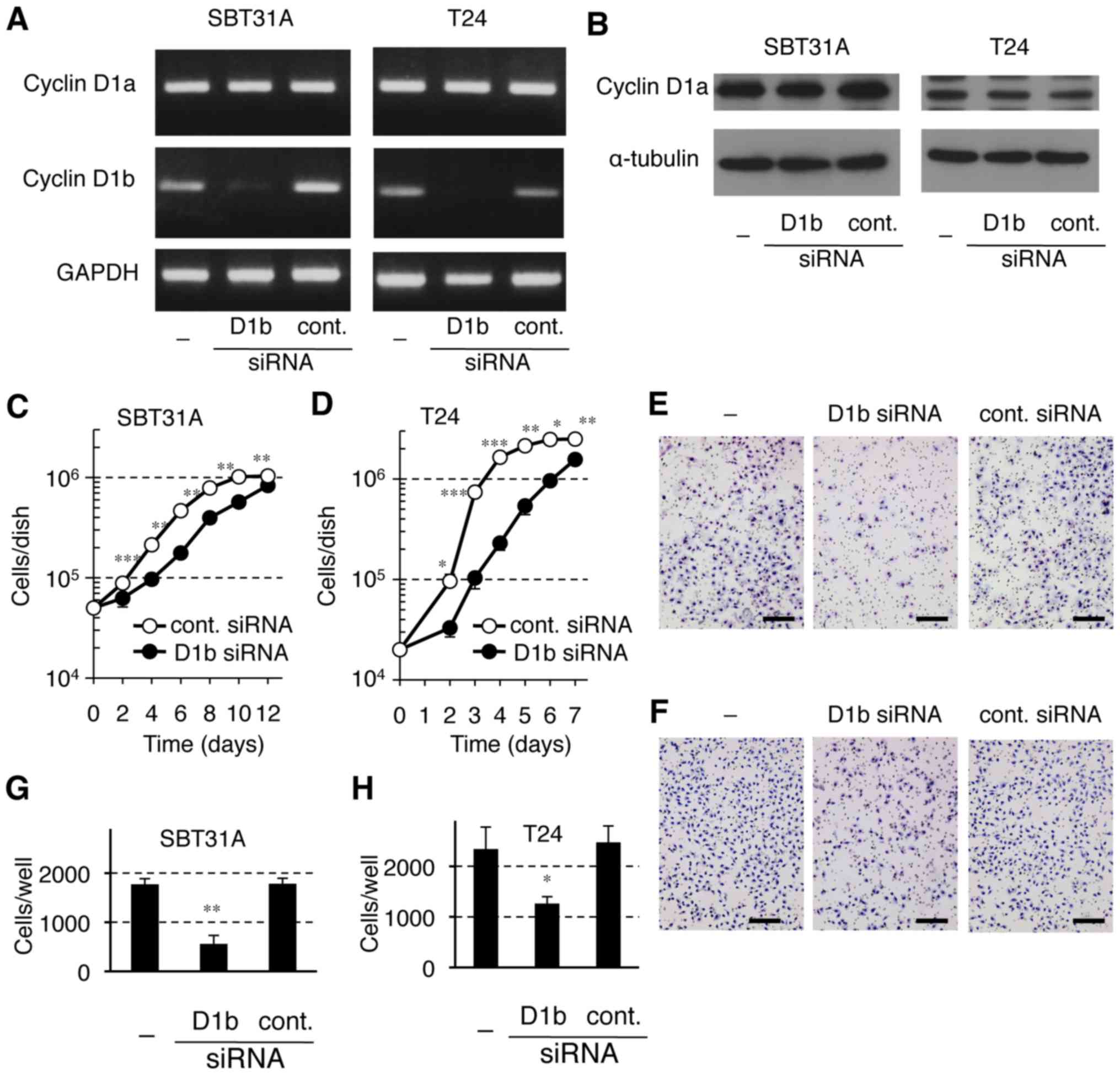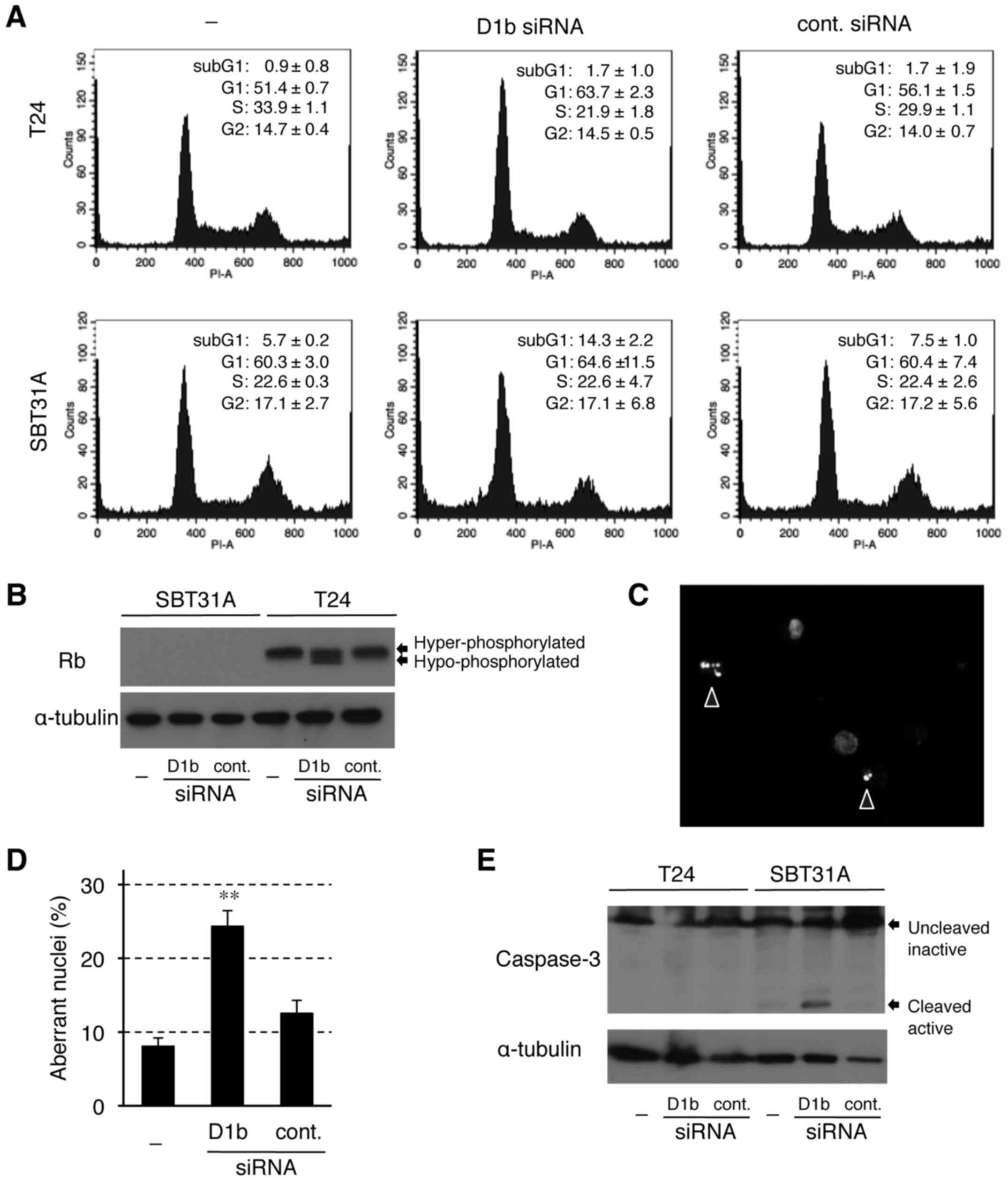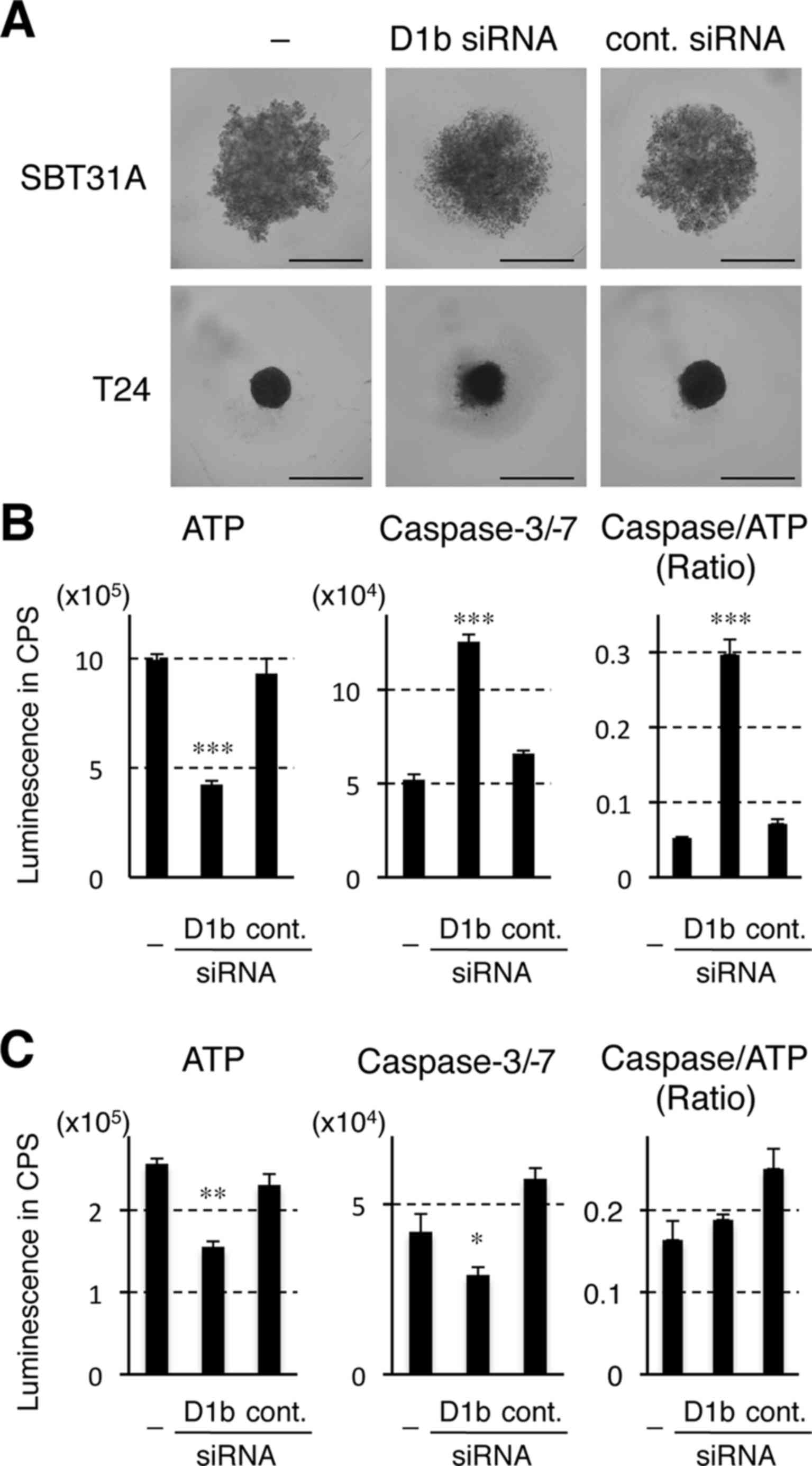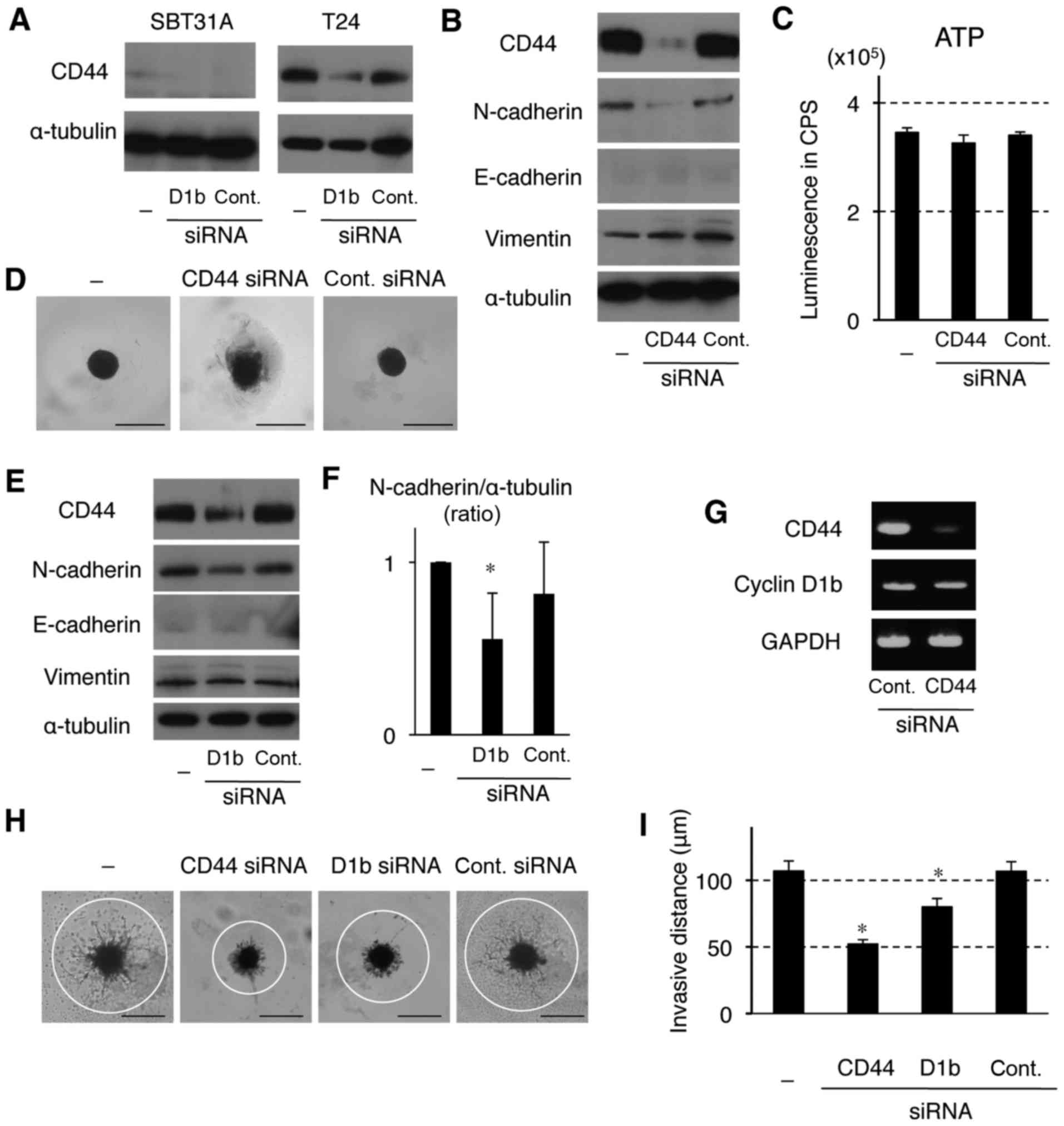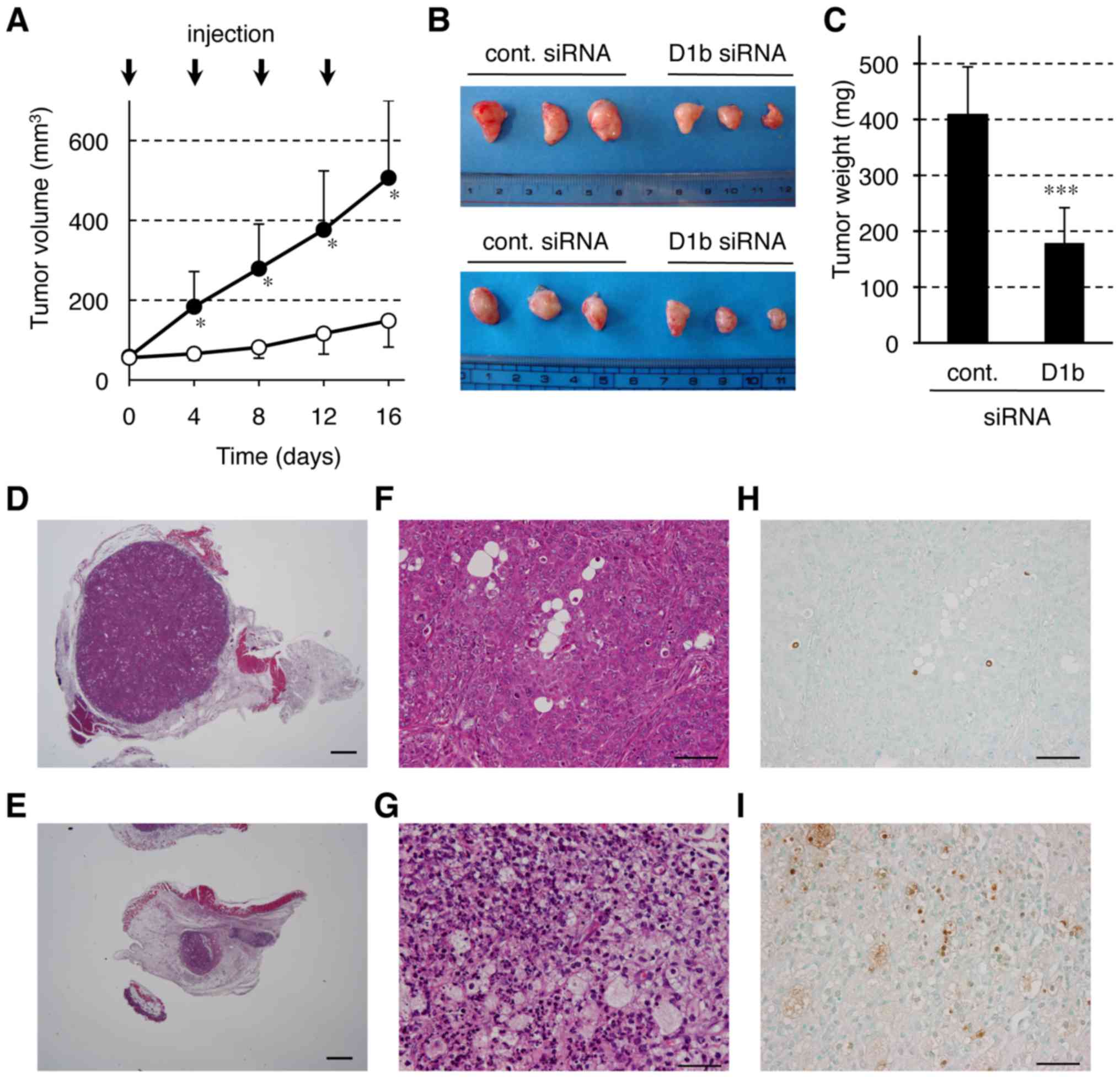|
1
|
Knudsen KE, Diehl JA, Haiman CA and
Knudsen ES: Cyclin D1: Polymorphism, aberrant splicing and cancer
risk. Oncogene. 25:1620–1628. 2006. View Article : Google Scholar : PubMed/NCBI
|
|
2
|
Sherr CJ: D-type cyclins. Trends Biochem
Sci. 20:187–190. 1995. View Article : Google Scholar : PubMed/NCBI
|
|
3
|
Lukas J, Parry D, Aagaard L, Bartkova J,
Strauss M, Peters G and Bartek J: Retinoblastoma-protein-dependent
cell-cycle inhibition by tumour suppressor p16. Nature.
375:503–506. 1995. View Article : Google Scholar : PubMed/NCBI
|
|
4
|
Musgrove EA, Caldon CE, Barraclough J,
Stone A and Sutherland RL: Cyclin D as a therapeutic target in
cancer. Nat Rev Cancer. 11:558–572. 2011. View Article : Google Scholar : PubMed/NCBI
|
|
5
|
Hosokawa Y, Gadd M, Smith AP, Koerner FC,
Schmidt EV and Arnold A: Cyclin D1 (PRAD1) alternative transcript
b: Full-length cDNA cloning and expression in breast cancers.
Cancer Lett. 113:123–130. 1997. View Article : Google Scholar : PubMed/NCBI
|
|
6
|
Lu F, Gladden AB and Diehl JA: An
alternatively spliced cyclin D1 isoform, cyclin D1b, is a nuclear
oncogene. Cancer Res. 63:7056–7061. 2003.PubMed/NCBI
|
|
7
|
Solomon DA, Wang Y, Fox SR, Lambeck TC,
Giesting S, Lan Z, Senderowicz AM, Conti CJ and Knudsen ES: Cyclin
D1 splice variants. Differential effects on localization, RB
phosphorylation, and cellular transformation. J Biol Chem.
278:30339–30347. 2003. View Article : Google Scholar : PubMed/NCBI
|
|
8
|
Burd CJ, Petre CE, Morey LM, Wang Y,
Revelo MP, Haiman CA, Lu S, Fenoglio-Preiser CM, Li J, Knudsen ES,
et al: Cyclin D1b variant influences prostate cancer growth through
aberrant androgen receptor regulation. Proc Natl Acad Sci USA.
103:2190–2195. 2006. View Article : Google Scholar : PubMed/NCBI
|
|
9
|
Holley SL, Parkes G, Matthias C, Bockmühl
U, Jahnke V, Leder K, Strange RC, Fryer AA and Hoban PR: Cyclin D1
polymorphism and expression in patients with squamous cell
carcinoma of the head and neck. Am J Pathol. 159:1917–1924. 2001.
View Article : Google Scholar : PubMed/NCBI
|
|
10
|
Howe D and Lynas C: The cyclin D1
alternative transcripts [a] and [b] are expressed in normal and
malignant lymphocytes and their relative levels are influenced by
the polymorphism at codon 241. Haematologica. 86:563–569.
2001.PubMed/NCBI
|
|
11
|
Bala S and Peltomäki P: CYCLIN D1 as a
genetic modifier in hereditary nonpolyposis colorectal cancer.
Cancer Res. 61:6042–6045. 2001.PubMed/NCBI
|
|
12
|
Paronetto MP, Cappellari M, Busà R,
Pedrotti S, Vitali R, Comstock C, Hyslop T, Knudsen KE and Sette C:
Alternative splicing of the cyclin D1 proto-oncogene is regulated
by the RNA-binding protein Sam68. Cancer Res. 70:229–239. 2010.
View Article : Google Scholar :
|
|
13
|
Kim CJ, Nishi K, Isono T, Okuyama Y, Tambe
Y, Okada Y and Inoue H: Cyclin D1b variant promotes cell
invasiveness independent of binding to CDK4 in human bladder cancer
cells. Mol Carcinog. 48:953–964. 2009. View Article : Google Scholar : PubMed/NCBI
|
|
14
|
Kim CJ, Tambe Y, Mukaisho K, Sugihara H,
Isono T, Sonoda H, Shimizu T, Kondoh G and Inoue H: Female-specific
rectal carcinogenesis in cyclin D1b transgenic mice.
Carcinogenesis. 35:227–236. 2014. View Article : Google Scholar
|
|
15
|
Kim CJ, Tambe Y, Mukaisho KI, Sugihara H,
Kawauchi A and Inoue H: Akt-dependent activation of Erk by cyclin
D1b contributes to cell invasiveness and tumorigenicity. Oncol
Lett. 12:4850–4856. 2016.
|
|
16
|
Kim CJ, Yuasa T, Kushima R, Tomoyoshi T
and Seto A: Antitumor killer lymphocytes in the peripheral blood of
a patient with transitional cell carcinoma of the bladder. Int J
Urol. 5:230–236. 1998. View Article : Google Scholar : PubMed/NCBI
|
|
17
|
Tambe Y, Yoshioka-Yamashita A, Mukaisho K,
Haraguchi S, Chano T, Isono T, Kawai T, Suzuki Y, Kushima R,
Hattori T, et al: Tumor prone phenotype of mice deficient in a
novel apoptosis-inducing gene, drs. Carcinogenesis. 28:777–784.
2007. View Article : Google Scholar
|
|
18
|
Weiswald LB, Bellet D and Dangles-Marie V:
Spherical cancer models in tumor biology. Neoplasia. 17:1–15. 2015.
View Article : Google Scholar : PubMed/NCBI
|
|
19
|
Robertson FM, Ogasawara MA, Ye Z, Chu K,
Pickei R, Debeb BG, Woodward WA, Hittelman WN, Cristofanilli M and
Barsky SH: Imaging and analysis of 3D tumor spheroids enriched for
a cancer stem cell phenotype. J Biomol Screen. 15:820–829. 2010.
View Article : Google Scholar : PubMed/NCBI
|
|
20
|
Xu H, Tian Y, Yuan X, Wu H, Liu Q, Pestell
RG and Wu K: The role of CD44 in epithelial-mesenchymal transition
and cancer development. Onco Targets Ther. 8:3783–3792. 2015.
|
|
21
|
Cairns P, Proctor AJ and Knowles MA: Loss
of heterozygosity at the RB locus is frequent and correlates with
muscle invasion in bladder carcinoma. Oncogene. 6:2305–2309.
1991.PubMed/NCBI
|
|
22
|
Cordon-Cardo C, Wartinger D, Petrylak D,
Dalbagni G, Fair WR, Fuks Z and Reuter VE: Altered expression of
the retinoblastoma gene product: Prognostic indicator in bladder
cancer. J Natl Cancer Inst. 84:1251–1256. 1992. View Article : Google Scholar : PubMed/NCBI
|
|
23
|
Logothetis CJ, Xu HJ, Ro JY, Hu SX, Sahin
A, Ordonez N and Benedict WF: Altered expression of retinoblastoma
protein and known prognostic variables in locally advanced bladder
cancer. J Natl Cancer Inst. 84:1256–1261. 1992. View Article : Google Scholar : PubMed/NCBI
|
|
24
|
Burkhart DL and Sage J: Cellular
mechanisms of tumour suppression by the retinoblastoma gene. Nat
Rev Cancer. 8:671–682. 2008. View Article : Google Scholar : PubMed/NCBI
|
|
25
|
Knudson ES and Knudson KE: Tailoring to
RB: Tumor suppressor status and therapeutic response. Natl Rev.
8:714–724. 2008. View Article : Google Scholar
|
|
26
|
Thangavel C, Boopathi E, Liu Y, Haber A,
Ertel A, Bhardwaj A, Addya S, Williams N, Ciment SJ, Cotzia P, et
al: RB loss promotes prostate cancer metastasis. Cancer Res.
77:982–995. 2017. View Article : Google Scholar :
|
|
27
|
Wei M, Zhu L, Li Y, Chen W, Han B, Wang Z,
He J, Yao H, Yang Z, Zhang Q, et al: Knocking down cyclin D1b
inhibits breast cancer cell growth and suppresses tumor development
in a breast cancer model. Cancer Sci. 102:1537–1544. 2011.
View Article : Google Scholar : PubMed/NCBI
|
|
28
|
Spring FA, Dalchau R, Daniels GL,
Mallinson G, Judson PA, Parsons SF, Fabre JW and Anstee DJ: The Ina
and Inb blood group antigens are located on a glycoprotein of
80,000 MW (the CDw44 glycoprotein) whose expression is influenced
by the In(Lu) gene. Immunology. 64:37–43. 1988.PubMed/NCBI
|
|
29
|
Misra S, Heldin P, Hascall VC, Karamanos
NK, Skandalis SS, Markwald RR and Ghatak S: Hyaluronan-CD44
interactions as potential targets for cancer therapy. FEBS J.
278:1429–1443. 2011. View Article : Google Scholar : PubMed/NCBI
|
|
30
|
Ponta H, Sherman L and Herrlich PA: CD44:
From adhesion molecules to signalling regulators. Nat Rev Mol Cell
Biol. 4:33–45. 2003. View Article : Google Scholar : PubMed/NCBI
|
|
31
|
Turley EA, Noble PW and Bourguignon LYW:
Signaling properties of hyaluronan receptors. J Biol Chem.
277:4589–4592. 2002. View Article : Google Scholar
|
|
32
|
Misra S, Hascall VC, De Giovanni C,
Markwald RR and Ghatak S: Delivery of CD44 shRNA/nanoparticles
within cancer cells: Perturbation of hyaluronan/CD44v6 interactions
and reduction in adenoma growth in Apc Min/+ MICE. J Biol Chem.
284:12432–12446. 2009. View Article : Google Scholar : PubMed/NCBI
|
|
33
|
Thiery JP: Epithelial-mesenchymal
transitions in tumour progression. Nat Rev Cancer. 2:442–454. 2002.
View Article : Google Scholar : PubMed/NCBI
|
|
34
|
Polyak K and Weinberg RA: Transitions
between epithelial and mesenchymal states: Acquisition of malignant
and stem cell traits. Nat Rev Cancer. 9:265–273. 2009. View Article : Google Scholar : PubMed/NCBI
|
|
35
|
Kim JB, Islam S, Kim YJ, Prudoff RS, Sass
KM, Wheelock MJ and Johnson KR: N-Cadherin extracellular repeat 4
mediates epithelial to mesenchymal transition and increased
motility. J Cell Biol. 151:1193–1206. 2000. View Article : Google Scholar : PubMed/NCBI
|
|
36
|
Lascombe I, Clairotte A, Fauconnet S,
Bernardini S, Wallerand H, Kantelip B and Bittard H: N-cadherin as
a novel prognostic marker of progression in superficial urothelial
tumors. Clin Cancer Res. 12:2780–2787. 2006. View Article : Google Scholar : PubMed/NCBI
|
|
37
|
Hazan RB, Phillips GR, Qiao RF, Norton L
and Aaronson SA: Exogenous expression of N-cadherin in breast
cancer cells induces cell migration, invasion, and metastasis. J
Cell Biol. 148:779–790. 2000. View Article : Google Scholar : PubMed/NCBI
|
|
38
|
Gravdal K, Halvorsen OJ, Haukaas SA and
Akslen LA: A switch from E-cadherin to N-cadherin expression
indicates epithelial to mesenchymal transition and is of strong and
independent importance for the progress of prostate cancer. Clin
Cancer Res. 13:7003–7011. 2007. View Article : Google Scholar : PubMed/NCBI
|
|
39
|
Bryan RT: Cell adhesion and urothelial
bladder cancer: The role of cadherin switching and related
phenomena. Philos Trans R Soc Lond B Biol Sci. 370:201400422015.
View Article : Google Scholar :
|
|
40
|
Jäger T, Becker M, Eisenhardt A, Tilki D,
Tötsch M, Schmid KW, Romics I, Rübben H, Ergün S and Szarvas T: The
prognostic value of cadherin switch in bladder cancer. Oncol Rep.
23:1125–1132. 2010.PubMed/NCBI
|
|
41
|
Gaglione M and Messere A: Recent progress
in chemically modified siRNAs. Mini Rev Med Chem. 10:578–595. 2010.
View Article : Google Scholar : PubMed/NCBI
|
|
42
|
Herr HW, Laudone VP and Whitmore WF Jr: An
overview of intravesical therapy for superficial bladder tumors. J
Urol. 138:1363–1368. 1987. View Article : Google Scholar : PubMed/NCBI
|
|
43
|
Okamura K, Ono Y, Kinukawa T, Matsuura O,
Yamada S, Ando T, Fukatsu T, Ohno Y and Ohshima S; Nagoya
University Urological Oncology Group: Randomized study of single
early instillation of (2″R)-4′-O-tetrahydropyranyl-doxorubicin for
a single superficial bladder carcinoma. Cancer. 94:2363–2368. 2002.
View Article : Google Scholar : PubMed/NCBI
|
|
44
|
Nogawa M, Yuasa T, Kimura S, Tanaka M,
Kuroda J, Sato K, Yokota A, Segawa H, Toda Y, Kageyama S, et al:
Intravesical administration of small interfering RNA targeting
PLK-1 successfully prevents the growth of bladder cancer. J Clin
Invest. 115:978–985. 2005. View Article : Google Scholar : PubMed/NCBI
|















